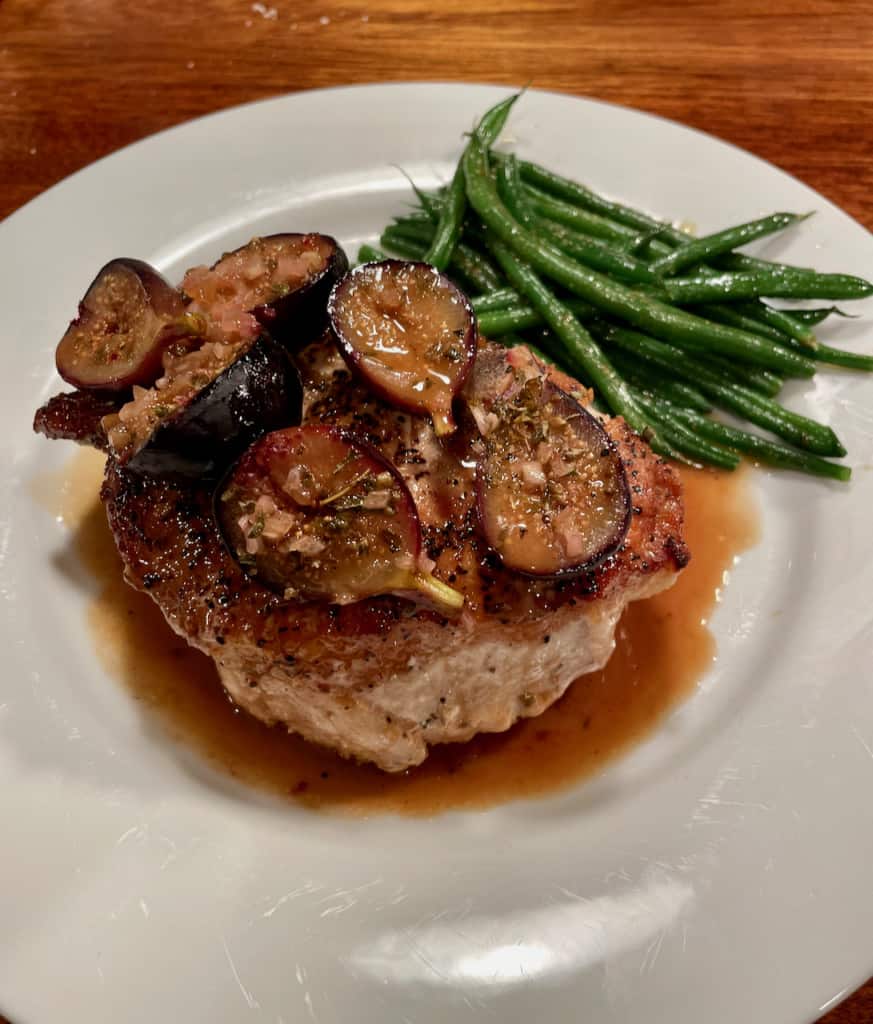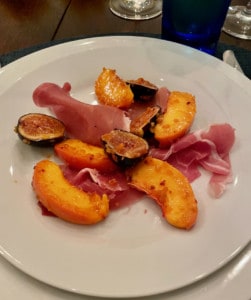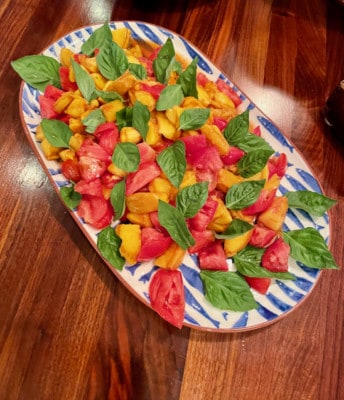We wait all year for Figs to appear. Then we celebrated their brief season with two superb dishes.


To us, few things are as delicious as fresh figs, straight from someone’s garden. First, there’s their wonderful scent. What awaits inside these little purple tear drops is their sweet moist taste. They have no juice, and you feel the crunch of their tiny seeds as you eat them. How to use them? First, we made a classic pairing of pork and fruit. We seasoned our figs with shallots and herbes de province and then marinated in Madeira and Red Wine Vinegar. Adding more Madeira and a little cream, the Fig Sauce lifted the oven-roasted Pork Chops to new heights. Then we made a salad taking advantage of our splendid local peaches and more pork—this time in the form of prosciutto. The coup-de-grace was adding Trader Joe’s Chili Onion Crisp to red wine vinegar. This made a truly extraordinary starter to our second figgy dinner. We loved both dishes and I wanted to know how to grow figs here on Long Island.
How to Grow Your Own Figs
This lovely end of Long Island is filled with fruit trees most especially peaches of every persuasion and in apple season, there’s no end to the varieties that are grown here. But the fig, alas, is not grown in abundance. They are certainly not native to our area but they’ve been grown here by immigrants from Italy and Greece for at least a century. According to Hicks, https://hicksnurseries.com, a nursery up island from here, ‘figs require warm temperatures both day and night for good fruit development and ripening”. This must have been an exceptionally good year for them here because it’s been very warm both days and nights. But then again “figs grow best when a constant moisture supply is available”. We are unfortunately in the midst of a genuine drought here so somebody’s been sneaking them water. Come fall, the whole tree has to be covered to overwinter at all well. So I think all things point to letting someone else grow the figs. We’ll just eat theirs.
 The 5000-year history of the Fig
The 5000-year history of the Fig
Iran and Egypt are the birthplaces of figs. Stone tablets dating to 2500 B.C. record the fig being eaten at that time. The word ‘fig’ comes from the Latin “Ficus” and an even older Hebrew word “Feg”. They were brought to Europe by the Romans and Greeks. Plato was so fond of the fruit that the Greeks called figs “Philosopher’s fruit”. The fig tree appeared in both the Bible and the Quran. The prophet Muhammad loved figs so much he repeatedly said he would like to see fig trees in paradise. In Genesis, the fig tree was mentioned prominently. Adam and Eve used the leaves of the fig tree to sew garments for themselves after they were cast out of the Garden of Eden (Genesis 3:7) Some scholars believe the forbidden fruit was not an apple but rather a fig. Today’s recipes are followed by our other fig treats.
Pork Chops with Roasted Figs
Pork and fruit are a great pairing. Here the Pork Chop is all dressed up with a simple fresh fig Madeira Cream sauce.

Ingredients
- 1 dozen fresh figs, cut in half
- ½ teaspoon herbes de Provence
- 2 teaspoons minced shallots
- 6 tablespoons Port, divided
- 2 tablespoons red wine vinegar
- 6 pork chops (about 1-inch thick and 2 ½ pounds total)
- Salt and freshly ground pepper
- 3 tablespoons vegetable oil
- 1 tablespoon heavy cream
Directions
- Step 1 Place the figs in a bowl and sprinkle them with the herbes de province and shallots. Add 2 tablespoons of Madeira and the red wine vinegar and stir gently to combine. Set aside for at least 1 hour, or up to 4 hours.
- Step 2 Generously season the pork chops on both sides with salt and pepper. Refrigerate for at least 1 hour (or up to 4 hrs.) until ready to serve.
- Step 3 Heat the oven to 400 degrees. In a large skillet, heat the oil over medium-high heat. When the oil is quite hot, pat the pork chops dry and add them to the pan. Brown the pork chops well on both sides, in batches, about 3 minutes on the first side and 2 to 3 minutes on the second.
- Step 4 Remove the pork chops to a plate, pour all the fat from the skillet, and add the remaining one-quarter cup of Port. Reduce to a syrup, add the cream and reduce that to a thick sauce, about 30 seconds. (It will thin with the cooking juices).
- Step 5 Return the pork chops to the pan and arrange the figs over the top. Add the marinade. Cover and place in the oven until the pork chops are cooked through, about 10 minutes.
- Step 6 Carefully transfer the pork chops and figs to a warmed serving platter. If necessary, reduce the sauce a little more over medium-high heat, and then spoon it over the pork and figs. Serve immediately.
Fig Peach and Prosciutto Salad
Peak-season peaches are combined with sweet mission figs and salty prosciutto and dressed with Chili Onion Crunch and a splash of red wine vinegar in an incomparable salad.

Ingredients
- 6 large peaches, peeled and sliced
- 8 ounces of prosciutto
- 12 mission figs, halved
- 6 tbsp. red wine vinegar
- 6 tbsp. Chili Onion Crisp
- 1 Pinch of Salt for each salad
Directions
- Step 1 Heat a pot of water large enough to hold all 6 peaches
- Step 2 Cut a cross in the base of each peach. Plunge peach into boiling water until peach starts to unpeel. Using a slotted spoon, remove each peach. Cool slightly. Remove peel
- Step 3 Slice peaches. Set aside.
- Step 4 In a small bowl stir together Chili Onion Crisp and red wine vinegar.
- Step 5 Layer peaches and prosciutto on salad plates.
- Step 6 Place halved figs on top. Spoon dressing over the salad and serve.
Pappardelle with Braised Chicken and Figs Adapted from Chef Kyle Bailey in Food and Wine Magazine













